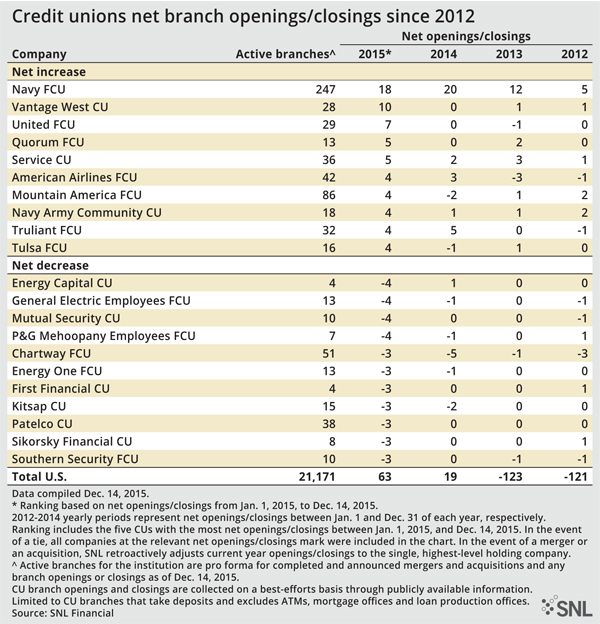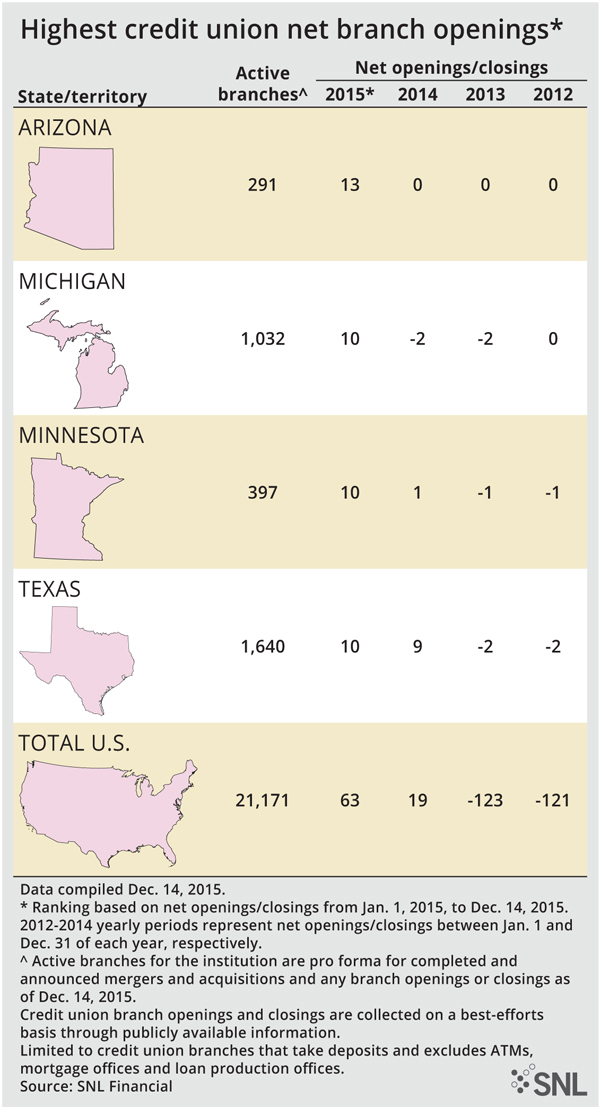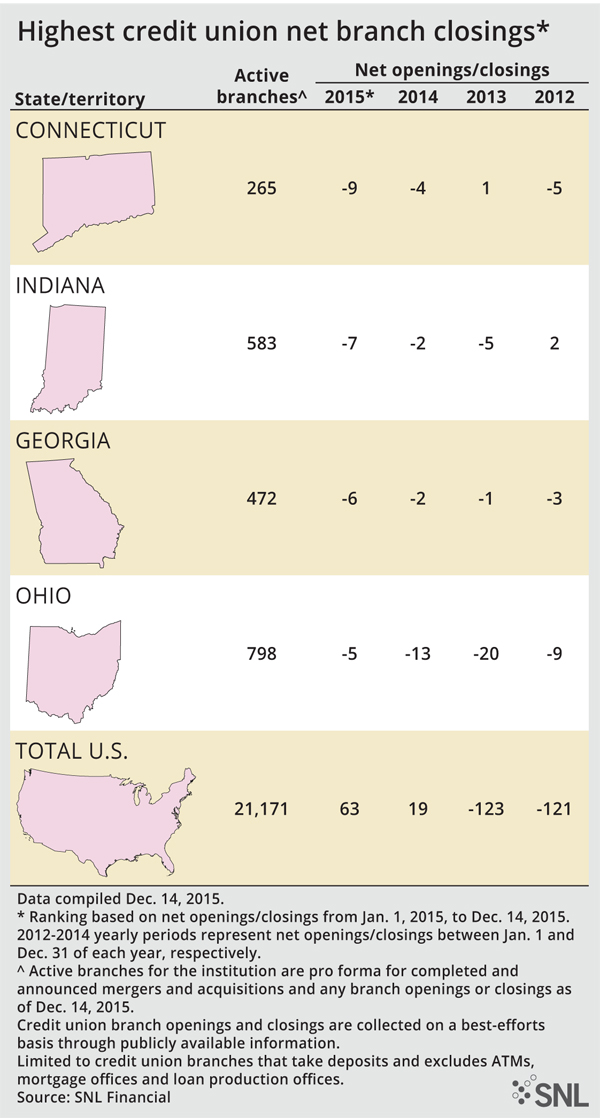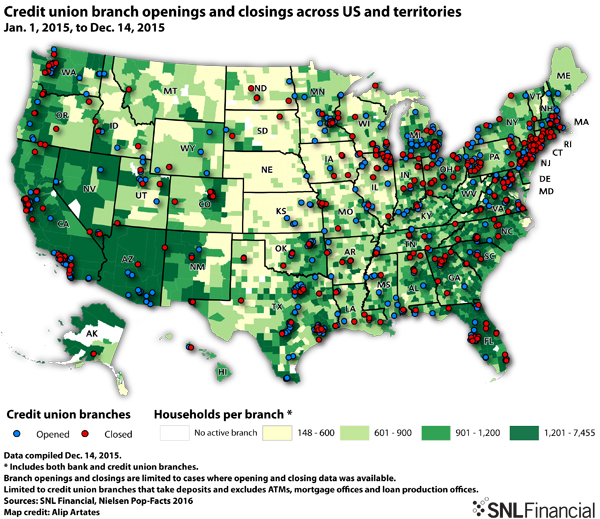Banks prune, CU branch count grows
SNL Report: Credit unions buck a major financial services trend
- |
- Written by SNL Financial
 SNL Financial is the premier provider of breaking news, financial data, and expert analysis on business sectors critical to the global economy. This article originally appeared on the subscriber side of SNL Financial's website.
SNL Financial is the premier provider of breaking news, financial data, and expert analysis on business sectors critical to the global economy. This article originally appeared on the subscriber side of SNL Financial's website.
By Jahanzeb Ali Khan and Ken McCarthy, SNL Financial staff writers
Continuously advancing technology makes it easier for people to conduct routine banking transactions remotely, but even consumers that enjoy that convenience still want to have face-to-face conversations for larger transactions, such as when financing a home purchase. Because of that and a variety of other factors, U.S. credit unions continue to add branches.
As of Dec. 14, there were 21,171 active credit union branches in the U.S. after 63 more branches opened than closed that far in 2015. In 2012 and 2013 combined the industry lost a net of 244 branches, an SNL analysis found.
At the same time, commercial banks in the U.S. reduced their cumulative branch network by 598 locations during the third quarter—more than in any of the three previous quarters, a separate SNL analysis found. There were 93,220 U.S. branches at the close of the third quarter, down from more than 99,500 in 2009, the last year in which branch counts increased.
Navy Federal flies the flag
Vienna, Va.-based Navy Federal Credit Union, the nation's largest credit union, saw a net increase of 18 branches in 2015 after expanding its branch count by 20 last year.
Larry Palochik, senior vice-president of member solutions for the California and Nevada Credit Union League, told SNL credit unions are extremely member-service driven, and many of them still believe that brick-and-mortar offices offer strong inroads not only into servicing their existing membership but also into expansion.
Credit unions, unlike banks, are not always primarily focused on the bottom line, he said.
"That means they are willing to go out there and look at brick-and-mortar because it's not just a financial decision for them," Palochik said.
Additionally, an increasing number of credit unions are utilizing technology and thus building smaller offices while employing omni-channel strategies. That allows those companies to expand their footprints and their service areas without adding as much cost as it would have taken in past years. In some cases, credit unions have been able to construct two buildings for what it once would have cost to build one, he said.
Arizona has seen the most net openings so far this year with 13 more branches opened than closed. On the flip side, Connecticut has nine fewer branches now than it started with at the beginning of 2015 and saw the greatest net decline among all states.
Texans like their credit unions
Texas, which has more credit unions than any state in the country with 1,640, has experienced a net gain of 10 branches in 2015. The Austin-Round Rock MSA, in particular, is a market that may be ripe for credit union growth. The MSA's population of residents 50 years old and over is expected to grow by 21.32% between 2016 and 2021, the largest percentage growth of any metro area in the country, an SNL analysis found. And because older customers tend to visit branches more often than younger people, there could be opportunities for credit unions in the market to add to their membership by adding offices.
Doug Foister, vice-president of research for the Cornerstone Credit Union League, told SNL that in addition to its relatively fast growing 50+ age segment, Austin is also wealthier and better educated than Texas overall. Austin has a mean family income of $95,226 versus $82,269 statewide while the percentage of Austin residents with a bachelor's degree or higher is 46% versus 27% of Texans overall.
Given its particular demographic characteristics, Austin credit unions that want to expand will need to provide investment programs geared toward retirement accounts that are sophisticated enough to retain current savings assets and to attract assets away from other sources. They will also need to offer appropriate insurance products as well as a wide range of convenient products and services beyond basic savings and lending, he said.
Navy Federal’s Palochik also said the recession played a part in the recent growth of credit unions' branch networks. During that time, many companies put a halt to expansion plans, but those projects in many cases have now been dusted off and put into action. There were also a significant number of credit union mergers during the recession, especially among smaller companies. That activity has opened up opportunities for some of those merged credit unions to expand into nearby markets.
In California in particular, Palochik said many of the larger institutions continue to expand their branch footprints while some of the smaller companies are in a holding pattern. He said the branch growth typically follows population growth trends, so in California that means markets including Orange County and the Inland Empire are areas of expansion focus. He said northern California too will see growth. "You follow the people and businesses and that's where branches will be," he said.
This article originally appeared on SNL Financial’s website under the title, "While banks prune, credit union branch count grows"
Tagged under Retail Banking, Channels, Community Banking, Feature, Feature3,


















